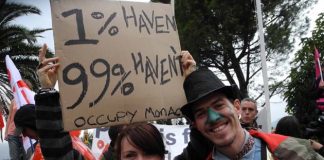MANY ANALYSTS thought the worst of the credit crisis passed four months ago, when the US Federal Reserve orchestrated a bailout of investment bank Bear Stearns. But recent events suggest otherwise.
July saw the second largest collapse of a financial institution in US history (California-based mortgage lender IndyMac). Supposedly worth $US32 billion, IndyMac’s demise led to panic and even an intervention by George Bush, who asked working class account-holders to “take a deep breath and realise their deposits are safe”.
Secondly, and much more seriously, the US government was forced to bailout two state-sponsored financial institutions, Fannie Mae and Freddie Mac. These bodies underwrite about half of all American mortgages (or about $US5 trillion in debt).
To do this, they need enough money to cover mortgage repayments when people default. But because the level of bad debt had skyrocketed, they literally began to run out of capital, losing 70 per cent of their share value.
New Deal
Fannie Mae (Federal National Mortgage Association) was established in 1938 as part of President Roosevelt’s “New Deal” response to the Great Depression. As Robin Blackburn explains in the New Left Review, “Fannie Mae made it easier and cheaper for prime borrowers to get a mortgage, using its federal guarantee and tax-free status to organise a secondary mortgage market that underwrote any residential mortgage up to a certain value.”
Predictably its demise has led to calls from neoliberals for privatisation.
But most commentators argued that the US government had no choice but to guarantee their status. This is partly for economic reasons—the New York Times editorial on July 15 claimed that if “they go down, so, perhaps, does the global financial system”.
But the US Treasury’s intervention is also motivated by political factors—in particular, the fear of a political backlash against another neoliberal response to the housing crisis. The Senate has just approved a $US300 billion package to refinance bad loans for struggling borrowers.
Still, the global fallout continues. New Zealand and Britain both appear to be on the verge of recession and even China’s growth forecasts have been downgraded.
Shockwaves
The resources boom may offer Australian capitalists a safety-net unavailable to its British or New Zealand counterparts, but most policymakers are shocked at the impact on the domestic financial system.
ANZ bank has just announced a $2.2 billion “write-down” (i.e. capital lost in US financial markets); the NAB has lost about a billion dollars. The stock exchange (ASX) recorded its worst performance in 26 years, shrinking by about 15 per cent in value.
The drying-up of credit, combined with higher interest rates and oil prices, have pushed inflation to nearly 4.5 per cent, the highest in 13 years.
Irrespective of whether the Australian economy can keep growing, the world financial crisis is contributing to a higher cost of living. Living standards are being eroded for the first time since the recession of the early 1990s.
Because of its commitment to free market economic policies, Labor is struggling to deal with this problem. We need to demand that the government protects working class people from the crisis by using its massive budget surplus to subsidise rising housing and fuel costs and re-investing in those public services, like transport, childcare, health and education, starved of funding.
By Tom Barnes




